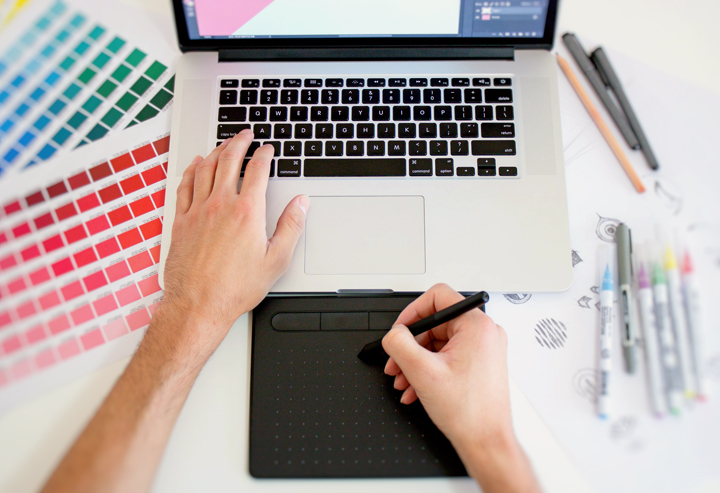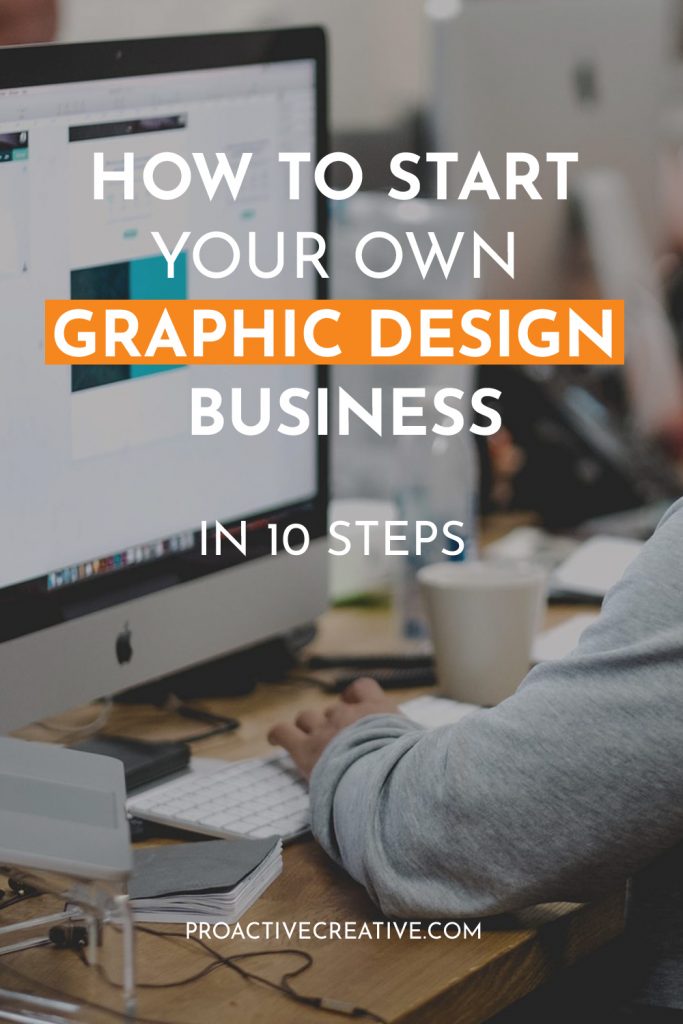So, you’re considering starting your own graphic design business. Maybe you’ve been working in a corporate role, or you fancy a career change. Either way, running your own graphic design business is rewarding but also challenging.
You’ll need grit, determination, and excellent design skills. If that sounds like you, then starting a design business is perfect for you.
This guide will walk you through everything you need to know about how to start a design business. As a graphic designer myself, I’ve worked both for companies and myself, so I’ve been there! I’m ready to share my experience and the knowledge I’ve gained to help you get off to a great start!
There are two main ways you can run a graphic design business. You can work as a freelance graphic designer, or you can create an agency with a team of designers.
In this article, I’ll cover this first option of working solo as a freelance graphic designer. It’s the simplest and quickest way to start your own graphic design business. And these steps will guide you through everything you need to know to get you started!
How to Start Your Own Graphic Design Business in 10 Steps
1. First of all, is a graphic design business right for you?

The first step is to think about how much effort you’re willing to put into a graphic design business. Starting any business will take a lot of hard work and effort to get it off the ground.
You may need to work long hours at first, and it can feel like an uphill struggle. It’s not just the design work itself. You’ll need to work on your marketing, website, online presence, finding potential clients, and dealing with the administrative side of your business.
So, before you even get started, stop for a minute and think. How committed are you to make this business a success? Are you willing to put in the initial grit and hard work?
When you’re working for yourself, it can take some time for things to start happening. You may not get booked out with clients in the very first weeks.
But when you work at it, there’s nothing like running your own graphic design business. If you’re here, it probably means you love design, and you also want to work for yourself.
In your own business, you call the shots. You get to decide how much you’ll charge, what services you’ll offer, and who you want to work with. You can set your hours and take a day off when you feel like it (so long as you still meet your deadlines).
How does that sound? Are you willing to put in the hard work up front to make your business successful? Are you motivated to make this happen?
If you’re already doubting it, starting your own graphic design business may not be the right step for you at the moment. But if that sounds exciting, then read on!
One more thing to consider is whether you already have the skills and tools you’ll need. You’re all set if you have worked as a graphic designer or studied graphic design. But if you’re transitioning, you may need to take a course and increase your skills first.
Lastly, do you have all the tools you’ll need to get started? At the very least, you should have a powerful laptop and the design software you’ll need. Make sure to do your research and see what else you’re missing.
My reviews of the best desktop computers, laptops, and tablets for graphic design are here.
Starting up a graphic design business doesn’t have to be expensive, but there may be some initial expenses to cover.
2. Consider Your Skills (and play to them)

So, you’ve decided to move ahead and start your own graphic design business! Great choice!
But graphic design is a huge industry, so it’s time to narrow down the services you’d like to offer. The more you can specialize, the quicker you’ll become an expert in that niche.
Think about what you’ve studied or the design work you’ve already done. What did you enjoy most, and what do you have the most experience in?
But most importantly, you should choose something you enjoy doing. You want to love the work you do every day – and it will show in the quality of your work if you do!
Here are some ideas of the different services you could offer:
- Logo creation
- Social media templates and graphics
- Web ads
- Business cards
- Web design
- Product Packaging
- Print leaflets, posters, etc
- Infographics
- Typography
- Animation
- Illustrations
- And more!
There are so many different areas within the graphic design business that you could specialize in. It’s worth considering which areas of graphic design are growing.
For example, web ads, social media, and infographics are becoming increasingly popular. But some areas are in decline or fiercely competitive, such as printed materials.
One last factor is the industry or types of businesses you’d like to work with. Who are your ideal prospective clients, and do they need the services you’ll provide? This groundwork will set you up for success and ensure your business is profitable.
3. Come up with your business name

It’s time to decide on your business name! This is an essential step, but don’t let it hold you back. Make a decision and then move on, instead of overthinking it.
You have two main choices: using your own name or coming up with a separate business name. Using your name makes it quick and easy to get started and is more personal, but it does have pros and cons. It’s very memorable but also makes it harder to scale if you want to grow into an agency.
Whatever name you choose, it should sound professional and premium. This will allow you to play the branding card.
The business name creates that first impression, so think it through carefully. How will people see your business? Does the name have any connotations? Don’t go for anything too cute or quirky with weird spelling – you want something simple and easy to remember.
Once you’ve come up with a name, you’ll need to check whether that name is free to use on all platforms. You should use the same name for your website and social media, or people may struggle to find you. Plus, you don’t want to infringe any copyright laws!
This website makes it easy to check quickly if your chosen name is taken as a URL and on social media.
4. Come up with a business vision and strategy

So, you’ve chosen your business name and decided on your services. But before you start looking for clients, I recommend mapping out a business strategy. It’s also time to think of your business vision.
Where do you want this business to go? If you have any income goals, get specific on them now so you know what you need to earn to cover your expenses. You can create a minimum income goal and a stretch goal!
Your immediate and long-term goals will affect your business and marketing strategy. Here are some questions to ask yourself:
- Do you want to work on individual projects or a repeat retainer with clients?
- How many clients do you want to work with?
- Will you work alone or hire subcontractors?
- Where do you want your business to be in 1, 5, and 10 years?
- How will you find clients?
- What are your immediate and long-term income goals?
You can look to see how your competitors are running their businesses. But don’t let comparison paralysis hold you back.
You’re running your own business, and your decisions need to make sense for you! Knowing what your competitors are doing is good, but you don’t need to copy anyone else. Make sure always to bring it back to your goals and vision.
5. Decide on your pricing

I’ve talked about coming up with income goals, but now you need to get into more detail. Let’s set up your pricing structure!
Many beginner graphic designers will charge an hourly rate. That’s one of the easiest and quickest ways to get started, so it has an advantage in the beginning. You can also raise your prices as you gain more experience and get your name out there.
But the downside of charging an hourly rate is that it’s hard to scale beyond a certain point. You’re limited to how many hours you can work, so you’ll reach an income ceiling and won’t be able to earn more. You may also need to keep track of your hours for clients, and some can even nitpick about how long tasks take.
It’s important to come up with project pricing. You’ll create prices for a deliverable or project, e.g., an infographic, set of templates, or a logo. With projects, you can charge what you’re worth (so long as people are happy to pay). You don’t need to track your time on a project, and clients know up-front what they will pay.
But you’ll often need to create a custom quote for each project. That can be a little time-consuming, and you should get as specific as possible to prevent scope creep. (When clients slip in ‘little extras,’ so you do more work for the same price).
If you want to charge on the higher end of the scale, you’ll need to look for clients who can afford these prices. Startups and solopreneurs tend to have tighter budgets. So you may have more luck with larger, established businesses.
When you’re first starting out, you may need to negotiate a bit. But make sure you value your time and work – don’t underprice yourself!
Whatever you decide, you need to feel comfortable and confident with your pricing. If not, clients will pick up on it! If they detect a lack of confidence in you, they may doubt the value you bring to the project.
6. Create a website and portfolio

You should have a website for your graphic design business. People can contact you through your website, and it should also showcase some of your work.
But a website doesn’t have to be complicated. You don’t want to get stuck at this step; a simple website will do.
You can hire a web designer to create a simple website, or you can go it alone. If you want to make your website yourself, be prepared to put in some time and research!
There are some accessible, user-friendly website services with drag-and-drop builders. You can create a simple website on Squarespace without spending too much money. Plus, there’s no coding necessary!
But if you plan on monetizing your website at some point, WordPress.org is another great choice. There’s a bit more of a learning curve, and you’ll also need to buy a domain name and hosting. I recommend using GoDaddy or Bluehost. You can also check whether your chosen URL is available on these sites.
For a basic website, all you need is a simple five-page website. It should include:
- A home page
- About Me page
- Services/Work With Me page
- Portfolio with work samples
- Contact page
Your portfolio should host a range of your best work samples. You can tailor the samples to the niche you want to work in, so people can see similar examples.
You can create samples specifically for your portfolio or use client work. Make sure to get their permission before you do this, though!
Don’t overthink your portfolio! It doesn’t have to be perfect right now. You can continue to hone and improve it over time, adding new samples and keeping it up to date.
If you want to find out more about creating an online portfolio, check out my guide here.
7. Look for your first graphic design clients

You have the basics set up, and now it’s time for the most exciting (and sometimes scary) part. Looking for clients!
First of all, you should already have some idea of who your ideal clients are. Are they small, medium, or large businesses? What industry are they in, and what services are they looking for?
It’s time to start networking and looking for graphic design jobs. Depending on your ideal clients, you can use a few strategies to connect with them.
Where (and how) to find graphic design clients
If you want to work with small businesses and solopreneurs, a great place to look is in Facebook groups. Here, you can network with business owners who need graphic design but don’t want to do it themselves.
There are groups specifically for graphic designers and design jobs. But you should also find out where your ideal clients hang out online and get into those groups.
Aim to offer value by answering questions and showing your knowledge and expertise. You can impress business owners and even set up a quick consultation call. That may turn into a paid project!
Some of the best Facebook groups are:
- Freelance Graphic Design Jobs from Home
- I Need a Graphic / Web Designer
- UI UX & Graphic Designer Jobs
- Business Owners, Entrepreneurs & StartUps
- Entrepreneurs Networking Group
- Women Helping Women Entrepreneurs
The next strategy is to search for design jobs on freelance and remote job boards. You can filter the results to look for design jobs; the best part is that it’s remote. So, you can work from home (or anywhere in the world).
Here are some of the best freelance job boards for graphic design:
You also have websites like Upwork and Fiverr, where you can bid for projects. These platforms tend to be super competitive, but they can be a good place to start. You can get more experience and your first testimonials, which can help lead to even better jobs!
Once you have your first clients, you can ask them for referrals. If you do an amazing job, they will talk about you with other business owners.
You can even set up a referral program and provide a small reward if they refer someone to you. That’s a nice way to thank them and encourage them to refer you out! There’s more to getting referrals from clients here.
I don’t recommend being too picky at first about what kinds of design jobs you take on. Even if these jobs aren’t the best paid, they can be a step up to where you want to go.
Don’t keep taking on lower-paid jobs, though! I’m just talking about those initial projects as you set up your business.
Scoring your first graphic design jobs will give you a huge boost of momentum. You’ll feel so excited and inspired that you’re earning money doing something you love! (Not to mention working for yourself!)
8. Impress your clients (and get some testimonials!)

You’ve got your first client(s) – congratulations! Now, it’s time to impress them and get some stellar testimonials and on-the-job experience.
In these first projects, you want to ensure that you overperform. And by that, I mean both in your work and your interactions with clients. That way, they will love your work and give you excellent testimonials. Then, you can use these recommendations to score even more work!
You should make working with you as simple and streamlined as possible for your clients. Ensure that you communicate well throughout the project and hit your deadlines (or even beat them!).
Below, I’ll recommend tools you can use to keep track of your projects. I’ve also got recommendations for how to send invoices, so you look very professional.
The more you impress these clients, the more likely they are to become repeat customers. They may even recommend you to other people. (I’ll let you in on a secret: Getting referrals is one of the easiest ways to find clients!)
You can share testimonials on your social media, website, and any other platforms you use. That will act as social proof and give you more credibility, as people will know what you’re capable of!
9. Set up your tech and tools

As your business grows, you’ll find you have more and more admin to keep up with. But the good news is that you can use some excellent tools to automate processes. And as a bonus, your business will look very professional and streamlined.
My first recommendation is an invoicing tool like Freshbooks, Wave, or Honeybook. You can create customized, branded invoices and send them on specific dates or set them to repeat. That will ensure you get paid promptly and reduce any back and forth communication.
Most of these tools can also track time, create proposals, and more. So, it’s a great first tool to invest in so your graphic design business looks professional.
Talking about invoices, you’ll need to find a way to take payments from clients. You want this to be as streamlined as possible, so they keep coming back to you.
If you use Freshbooks or similar, you can set it up so clients can pay by clicking a button on the invoice.
Another excellent tool you should use is a project management system. Both Asana and Trello are excellent tools, or you can try out the new kid on the block, ClickUp.
A PM tool will help you keep track of all your projects and subtasks, so you never miss a deadline. You can also communicate with clients, give updates, and ask questions. It’s much quicker than sending an email!
Lastly, I would recommend creating an onboarding document. You can send it to clients when you sign a project with them to get off to a good start. It should include your contact details, availability, and project deadlines and milestones. You can add in anything else they need to know or customize it for each client.
10. Create a dedicated workspace

You’ll need a proper workspace as you spend more time on your graphic design business. You can start off working on your laptop on the sofa, but you’ll soon have to upgrade!
A desk with a monitor, keyboard, and mouse is essential. You’ll need a powerful computer and quality monitor to see your designs in detail. Your setup should also be ergonomic, so you’re comfortable even after a long workday.
Having a dedicated workspace will boost your productivity and focus. You can concentrate on your work and let your creativity flow. It’s crucial that you have a quiet space for any client calls, too.
I’ve got recommendations for the best mouses, left-handed mouses, and ergonomic mousepads. Plus, the best monitors, desks, and keyboard trays for graphic designers.
You won’t regret investing in a comfortable workspace for your design business!

The Wrap Up
Starting your own graphic design business could be the best decision you ever make as a creative! But it will take some hard work and effort to get it up and running.
With these tips, you’ll be off to an excellent start. Work through the steps, and imagine where you’ll be a year from now! Make sure to come back to your vision and dream when you’re feeling tired or demotivated. You can do this!
Let me know if you have any questions below! And make sure to follow me on Pinterest for more tips, guides, and reviews!






ty so much!! i do have a question. i am completely new with 0 experience but will look into UDemy for courses. my question is- do i need all 3 (laptop, desktop & tablet) or can i only purchase one. ? what program do you suggest? illustrator.? i want to create logos, bday cards, stickers
Hi Vee,
you are welcome. for Illustrator, you don’t need a desktop nor a tablet, a Laptop is enough.
Good luck